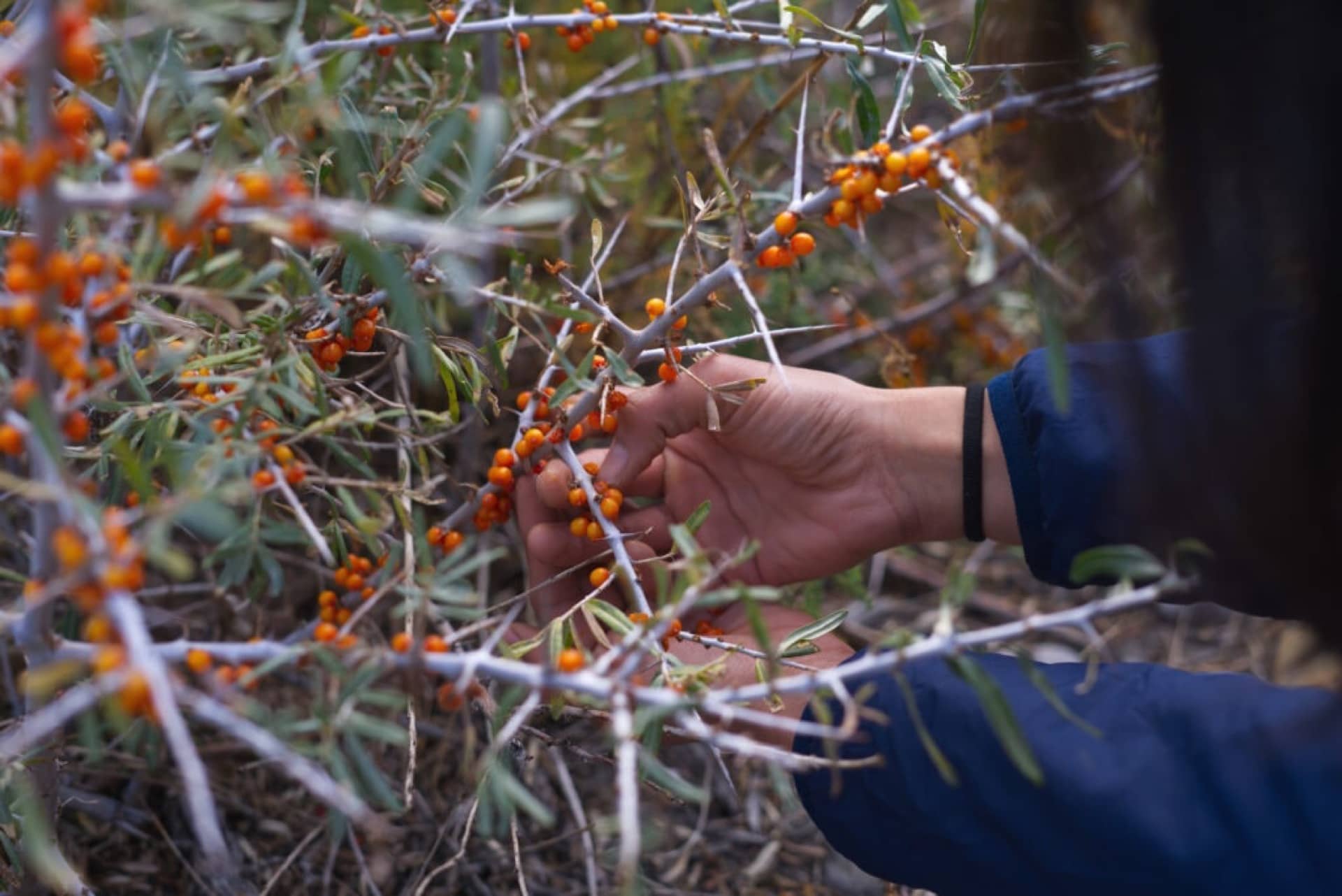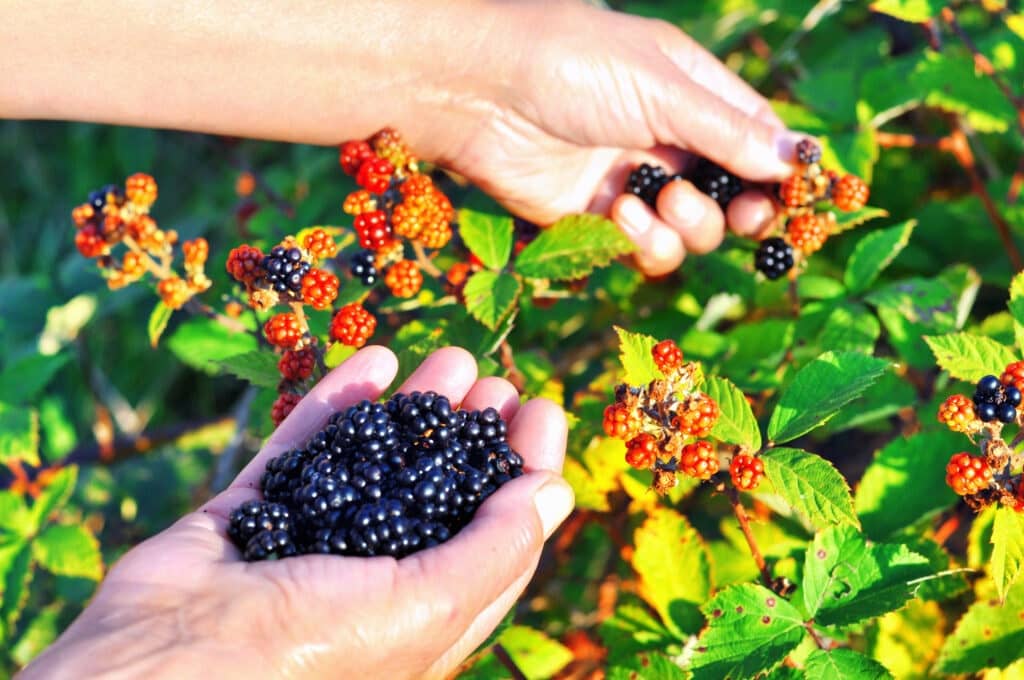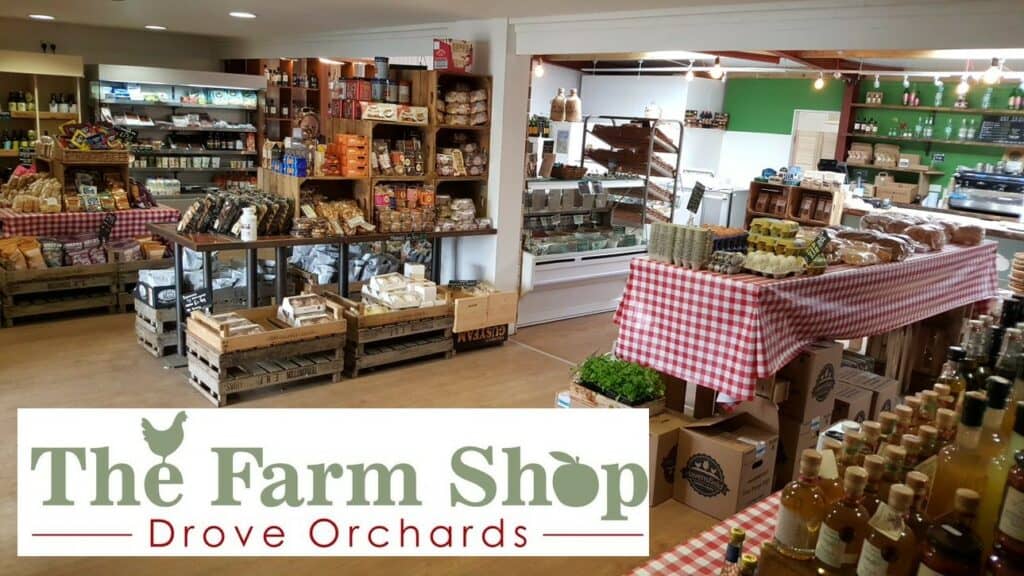
Gathering Sea Buckthorn
The winter land has its own bounty, ripe for foragers who know where to look. On Norfolk’s cliffs the silver blue Sea Buckthorn blazes with glowing orange berries from early autumn. The Greek name is ‘hippophae rhamnoides’ meaning ‘shining horse’ because of the glossy sheen the fruit gave stallions’ coats.
These tough native shrubs spread networks of suckers, holding the sand together, stabilising coastal erosion. Sea Buckthorn thrives in the Himalayas where the juice is a popular restorative and was used in the 13th century as a tonic for Genghis Khan’s armies. It’s a survivor, dominating more fragile species, so forage with a clear conscience – but beware the stiletto sharp thorns! Wear long sleeves, good thick gloves and bring a container for the thin-skinned berries which burst as you pick them. A trick is to take secateurs, snip off whole branches and freeze the lot before snapping the berries off the stem.
Sea Buckthorn are dioecious, meaning the plants are either male (pollen and flowers) or female (abundant fruit). Tart and tangy with a bitter note, Sea Buckthorn is a Vitamin C rich superfood, ideal for making syrups, curds and jellies with plenty of recipes online. Here’s one of our favourites – Sea Buckthorn Gin. What a gorgeous sustainable homemade Christmas present!
Sea Buckthorn Gin
600g Sea buckthorn berries
300g sugar
1 litre Gin
- Put the gin, sugar & berries into large sterilised jars
- Shake it up
- Wait 4-6 weeks, shaking occasionally
- Strain through cheesecloth into bottles
- Drink – cheers!

Blackberries
Ouch! Foraging for wild blackberries is a prickly business! Lucky Norfolk’s scientists have a solution – did you know the first thorn-free blackberry bushes were developed in 1941 at the John Innes Centre of biosciences in Norwich? The ‘Merton Thornless’ was the first domestic variety, tamer than the vigorous briars growing in abundant tangles on Norfolk’s country lanes and commons.
Considered the archetypal autumn fruit, the berries actually ripen in late summer, from August to October. It’s said Lucifer fell from heaven on Michaelmas Day (29 September), landed in a bramble patch and furiously spat on the berries, so any fruit you pick after that date is bitter. Fact is, a late heatwave or sudden cold snap can shrivel the crop, devil spit or not…
The sweetest, plumpest blackberries grow in direct sunlight although the the juiciest fruit always seems to be just out of reach. Typical! Wear long sleeves to guard against scratches, hold branches aside with a sturdy stick and pop a few in your mouth for a burst of sharp juice as you forage. Best of all, stain fingers purple picking yourself a bagful to bake crumbles and pies for the supper table. Or freeze to make bramble ice cream and midwinter muffins, a delicious homemade teatime treat.
You’ll be sharing the seasonal banquet with native and migratory birds: redwings, fieldfares, thrush and blackbirds. Insects and small mammals love them too so remember, take only what you need. And enjoy!

Picking Apples Under a Norfolk Sky
What does autumn mean to you? Sure, you could just order another pumpkin spice latte. But imagine this…wandering among gnarled trees under big Norfolk skies, breathing in the clean, green scent of apples and ripe orchard fruits gleaming crimson, amethyst and bronze in glorious autumn sunshine. These golden days are made for being outside in perfumed air, senses intoxicated, using dormant muscles, gathering the harvest to sustain body and soul in the coming winter. At Drove Orchards you can pick your own apples, plums, pears and gages straight from the trees. You’re free to try varieties first or chat to staff, always delighted to suggest new flavours. There are 40 acres of orchards around the Farm Shop, including 160 different apple and pear varieties. Some are familiar, most are rare, grown in East Anglian heritage orchards, a lovingly curated collection of over 120 types native to the region. Delicious and unusual, they preserve a little slice of our history.
While apples are the core of Drove Orchards, the Farm Shop is packed with produce from Norfolk and beyond; find fruit, vegetables, bread, wine, local beer, artisan gifts and much more. Plus fabulous butchery and deli counters! Of course there’s plenty of home grown cider and pressed apple juice.Yet are few things as pleasurable as biting into a crisp freshly picked apple. In a busy digital age we yearn be part of nature’s feel good seasonal rituals, so how about making apple picking a family tradition?
Build your own itinerary
If you fancy creating your own itinerary for a day trip to Norfolk or a longer visit, it couldn’t be simpler. Just go to Search Activities and select from our wide range of free and paid-for experiences, saving any that capture your imagination with the click of a button.
Once you’ve finished, you’ll find all the information stored in My Favourite, where you can drag and drop activities to create your own day-by-day itinerary! You can download this to a calendar and even share it with friends.
